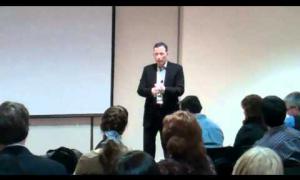By David Murray, editor, Vital Speeches of the Day.
On the morning I left for the Ragan Speechwriters & Executive Communicators Conference, my seven-year-old daughter got up early to see me off. She asked what I was doing in Washington.
Giving a speech, I said.
“Well, what’s the speech about?” asked Scout, herself a dabbler in oratory.
It’s about speeches.
“You’re giving a speech,” she said slowly, “about speeches.”
Yes, I said.
“That’s weird.”
Be that as it may, speechwriters only get together en mass once a year, and last year’s show was snowed out.
So the 250-ish scribes at American University in D.C. March. 7-9 were eager to discover what, in two years, had changed, what had stayed the same.
Speechwriters are still trying to figure out how they’re going to get their execs involved in social media when they won’t even sit down to talk about speeches.
They’re still trying to wean the execs off PowerPoint and away from the lectern by replacing scripts and TelePrompTers with sweet-sounding “confidence monitors.”
And though they’re still loathe to reveal enough of themselves to interest an audience, they’re starting to learn some tricks for drawing out good stories.
“You could never use this in a speech, but ….” When the speaker says that, said onetime White House writer Eric Schnure, get your pencil ready, because you’re about to get the perfect anecdote for the speech.
Here were the main areas of agreement at the 2011 speechwriting show:
• Two words: TED Talks. Want to shame execs into dropping the PowerPoint and dashing out from behind the lectern? Show them what modern speeches look like. Show them a few TED Talks, which the Toronto Star aptly described as having “captured the Web’s shiny, aspirational spirit.” (As opposed to PowerPoint’s dreary, dry dullness.)
In a session about TED Talks—many speechwriters weren’t aware of what they were—veteran Johns Hopkins speechwriter Mike Field showed one, and talked about how they work. They’re limited to 18 minutes, they eschew notes and lecterns and they rely on three “confidence monitors,” floor-bound screens on the front of the stage. One shows the remaining time of the talk, the second shows the current slide being shown and the third shows the next slide on deck.
Most importantly, the TED formula involves heavy personalization of the subject matter. Field demonstrated the difference, contrasting a mock introduction to a traditional speech opening, which spoke abstractly about the urban problems of Baltimore, with a TED-style intro, which began with Field’s personal connection to Baltimore, and a tearful car-trip he took with his mother to Detroit ….
The point is, TED style is the cutting edge, and if you can help your speaker to get even a tiny bit closer to it, you will have improved his or her speech communications.
• When the times get tough, the tough find simple ways to measure their usefulness. In a down-to-earth session on how speechwriters can measure their worth, Pfizer’s senior director of executive communications Grant Neely recommended that the speechwriter do such things as, “Go in and ask [attendees], ‘What did you think of the speech?’”
Their quotes, combined with a few quantitative responses on regular, standard, repeated scorecards and drawn conclusions “from I, the executive communication professional,” will begin to develop trends that can illuminate what speeches are accomplishing, and how audiences are perceiving the CEO and his or her message.
• Executive communicators have no excuse for sitting on their hands when it comes to social media. Participating themselves in social media is step one in getting senior execs involved.
“By doing it myself,” was Novell chief marketing officer John Dragoon’s answer to the question of how he got the CEO to start using social media. He participated on his own behalf on several social media platforms—most notably Facebook, LinkedIn and Twitter—until he could credibly share the conversation he was hearing with senior leaders and ask them whether they wanted to participate. (They did.)
Boe Workman, leadership communication chief at AARP, says the exec doesn’t have to personally participate in social media to benefit from it. Pungent, relevant speech excerpts, televised interviews and utterances of all kinds can be sliced, diced and spread all over the social media-sphere without the senior exec lifting a finger. And while executive communicators are spreading all that stuff, they ought to be listening, too.
Meanwhile, an attendee next to me muttered, “I still don’t understand Twitter.” Which I thought might make a pretty good t-shirt.
Or is that weird?

